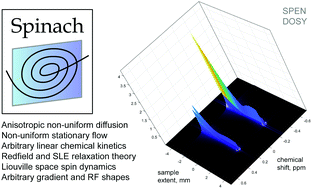Efficient simulation of ultrafast magnetic resonance experiments
Abstract
Magnetic resonance spectroscopy and imaging experiments in which spatial dynamics (diffusion and flow) closely coexists with chemical and quantum dynamics (spin–spin couplings, exchange, cross-relaxation, etc.) have historically been very hard to simulate – Bloch–Torrey equations do not support complicated spin Hamiltonians, and the Liouville–von Neumann formalism does not support explicit spatial dynamics. In this paper, we formulate and implement a more advanced simulation framework based on the Fokker–Planck equation. The proposed methods can simulate, without significant approximations, any spatio-temporal magnetic resonance experiment, even in situations when spatial motion co-exists intimately with quantum spin dynamics, relaxation and chemical kinetics.

- This article is part of the themed collection: 2017 PCCP HOT Articles


 Please wait while we load your content...
Please wait while we load your content...